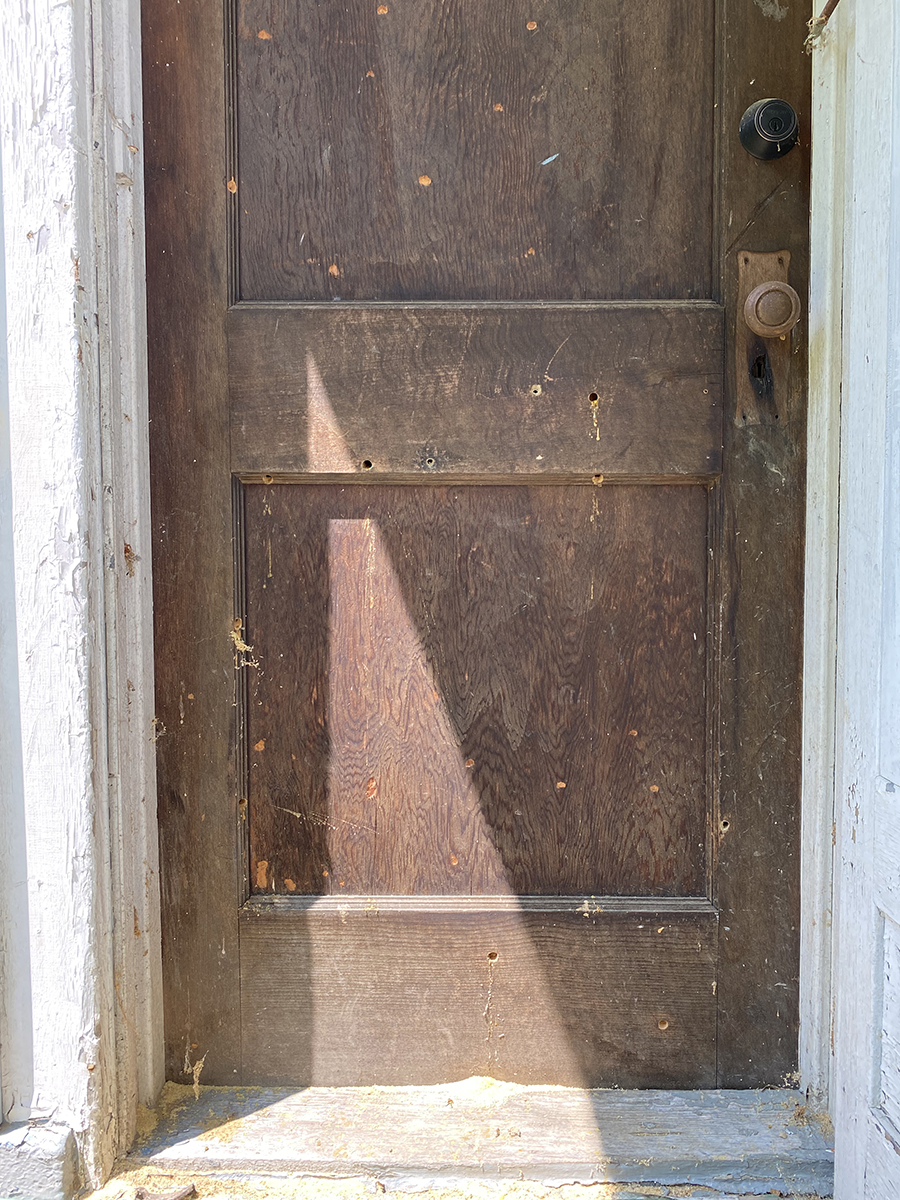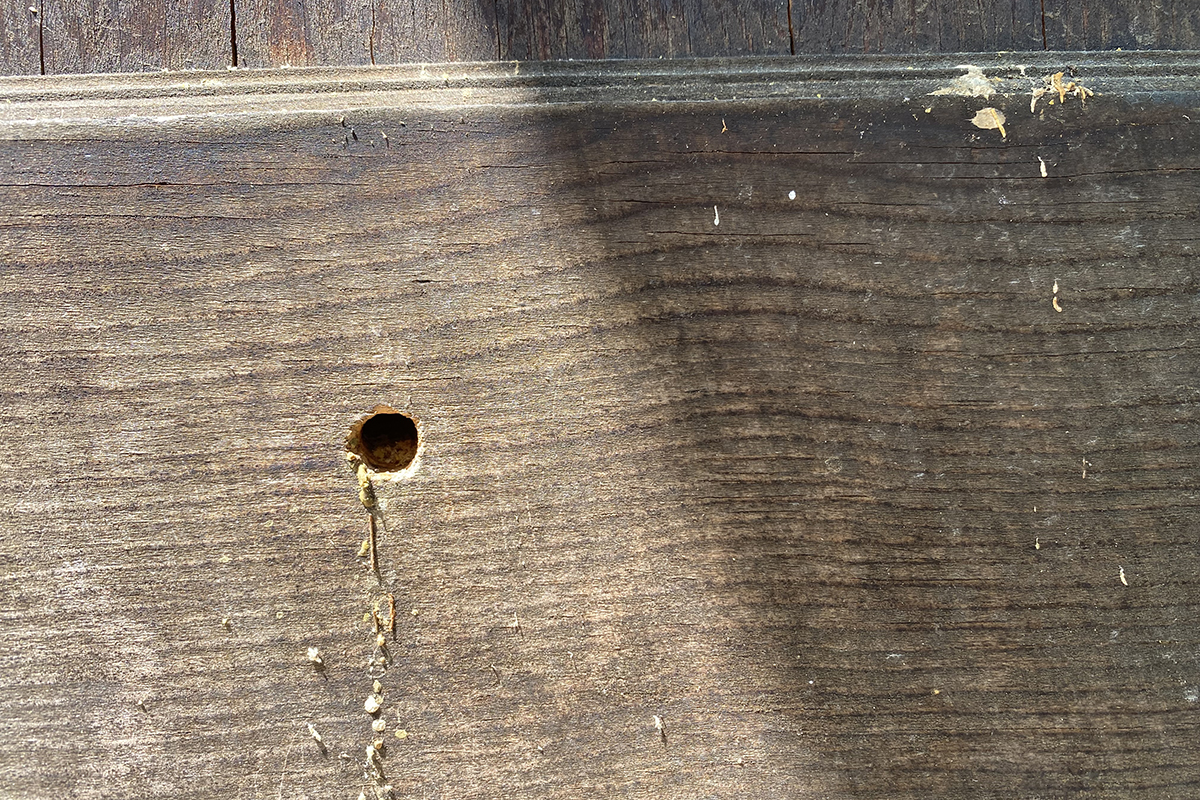
I really enjoy watching all forms of wildlife go about their business. My favorite might be the chipmunk that samples the fruits and vegetables from my garden. He carefully scampers along the rock wall that borders it, ducks under the large leaves of a squash or cucumber and works his way to the interior for a snack. I also, thoroughly enjoy the great blue heron that stops by my creek. Watching him from the sliding glass door, I try to envision the invertebrates he’s digging out of the sand for lunch.
Perhaps, the joy animals bring me is what ultimately led me to have such an interest in conserving their ecosystems and helping them survive. I find myself thinking more and more about planting beneficial trees and native wildflowers, turning patches of manicured lawn into grassland areas or forest edges and providing nest boxes and bee hotels.
This mindset was challenged a couple of weeks ago when I witnessed eastern carpenter bees crawl into holes left behind by an old satellite dish that had been removed from the side of a house. My fear of structural damage to homes runs deep. My love of nature just runs a bit deeper. So I did more research.
Eastern carpenter bees have the potential to cause considerable damage to wooden structures. However, by understanding their behavior and taking their lifecycle into account we can prevent damage to manmade structures without harming these important pollinators.

Eastern carpenter bees
Eastern carpenter bees are a large bee species native to North America. They are often mistaken for bumble bees because of their size and fuzzy thoraxes. Along with other native bee species, they pollinate 15% of our agricultural crops and many flowering plants found in our gardens and natural areas.
Despite their similar appearance to bumble bees, they live much differently. Bumble bees are social insects that live in colonies underground. All of the bumble bees within a colony care for the nest and rear offspring. Carpenter bees are less social and they live above ground in cavities they create by chewing perfectly round holes with their specialized mandibles.
The durable homes carpenter bees create can be used year after year, which is how large nests are formed. A female carpenter bee starts a nest by excavating a series of tunnels for her offspring and laying an egg on a ball of pollen and nectar within each chamber. When a nest is started from scratch, a female is able to rear four to five offspring in a season. When an existing nest is used, a female will expand it and rear more offspring. With each generation, the nest becomes more elaborate.
Preexisting nesting sites are desirable because they offer more space, time and energy to raise offspring. The reproductive success of a female carpenter bee is directly related to the size of her nest. When she doesn’t have to focus a lot of time and energy on building a nest from scratch, she is able to produce more offspring during her lifetime.
Although carpenter bees are typically solitary nesters, they will sometimes live in small related groups when the availability of nesting sites or materials is limited. Within these groups, one primary queen will lay eggs and forage for food and other subordinate queens will defend the nest from predators, parasites and competing carpenter bees. The subordinate queens do not contribute to the feeding or care of the young, however, the primary queen will sometimes feed the other adult females in the nest. In very large nests with multiple branches, there can sometimes be more than one primary queen.
As solitary bees, carpenter bees typically live one year. When they nest in social groups, the subordinate queens can live up to three years.
Over the course of a season of caring for her young and foraging for food, a primary queen’s health declines. When she dies, a subordinate queen inherits the nest. In the case of solitary carpenter bees, a deceased queen’s nest is left vacant for a new occupant.
Adult carpenter bees emerge from hibernation in April and May to begin foraging for food, constructing nests and mating. By the end of July, brood chambers are filled with pollen balls and larvae. The larvae will emerge as adults in August and begin foraging. They will continue foraging until temperatures and a lack of food sources force them into hibernation for the winter.
Eastern carpenter bees will defend their territory when they are threatened, however, they are unlikely to sting. Males are the most defensive carpenter bees and they lack stingers. They choose locations that are close to females and defend their mating territory with defensive flight maneuvers. Females will defend themselves and their nests if they feel threatened, but they are unlikely to sting unless they feel physically threatened.
Managing carpenter bees
Taking preventative measures, doing regular home maintenance and providing alternate nesting sites are all ways to ensure you live peacefully with established eastern carpenter bee populations.

Provide alternate nesting options. Providing a suitable habitat for eastern carpenter bees will help reduce bee-human conflicts and give you an opportunity to enjoy them in your own backyard. Female carpenter bees are particularly attracted to nesting in untreated pine and cedar lumber. These types of lumbar can be used to lure carpenter bees away from other wooden structures or to establish a pollinator habitat. You can arrange the wood as simply or as elaborately as you’d like.
Choose composite materials. Eastern carpenter bees will not nest in composite building materials and they are less attracted to treated lumber. When building a new wooden structure or adding exposed wood to a pre-existing one, choose materials they don’t like and treat materials to deter them.
Paint, stain or apply a coat of almond oil to wood surfaces. Surface treatments make wood unattractive to carpenter bees. Applying a coat of paint, stain or almond oil to wood surfaces will deter carpenter bees from constructing new nests.
Seal preexisting holes in the exterior of your home. Seal any preexisting holes in the exterior of your home and holes that may be left behind from removing a satellite dish, a flagpole, a light fixture or other hardware. Carpenter bees create holes that are about a half-inch in diameter. Any preexisting hole that’s about this size will be attractive to them. And sealing these holes after they’ve already found them will have limited success because they can easily chew through the material you used to seal them after the fact.
Replace nesting boards. Established nests will not be impacted by surface treatments and, as I mentioned above, you’ll have limited success with sealing individual holes. If the board the bees are nesting in can be removed, relocated and replaced with one that has been treated that would be the best course of action to keep them from tunneling further into your house. It’s also an opportunity to establish a native bee habitat in your backyard.
Chemical treatment. When carpenter bees have been allowed to establish an extensive nest over the course of many generations, it can turn into an infestation that poses a threat to the structure of your home. In these instances, insecticidal treatment may be necessary. These applications should be done by a professional to ensure the nest is treated properly without impacting other beneficial insects. Applying a powdered formulation of insecticides inside the nest will ensure it is destroyed while limiting the risk of non-target exposure. Following the chemical treatment, seal any entrances and treat the surfaces of the wood with paint, stain or almond oil to deter future carpenter bees from moving in and reestablishing the nest.










